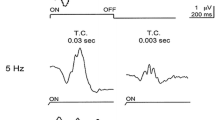Abstract
Purpose
To study clinical patterns of disease onset in monogenic retinal dystrophies (MRD), using an epidemiological approach.
Methods
Records of patients with MRD, seen at the University Eye Hospital Tuebingen from 1994 to 1999, were selected from a database and retrospectively reviewed. For analysis, patients were divided into 2 groups by predominant part of visual field (VF) involvement: group 1 (predominantly central involvement) included Stargardt disease (ST), macular dystrophy (MD), and central areolar choroidal dystrophy (CACD), and group 2 (predominantly peripheral involvement) included Bardet–Biedl syndrome (BBD), Usher syndrome (USH) I and II, and choroideremia (CHD). Age, sex, age of first diagnosis, age of visual acuity (VA) decrease and VF emergence, night blindness and photophobia onset, types of VF defects and age of its onset, color discrimination defects and best corrected VA were analyzed.
Results
Records of 259 patients were studied. Men were more prevalent than women. Mean age of the patients was 47.2 (SD = 15.6) years old. Forty-five patients in the first group and 40 in the second were first diagnosed between 21 and 30 years of age. Ninety-four patients in the first group had VA decrease before 30 years of age; in the second group, 68 patients had VA decrease onset between 21 and 40 years of age. Forty-four patients in the first group noticed VF at an age between 21 and 30 years, and 74 patients between 11 and 30 years in the second group. Central scotoma was typical for the first group, and was detected in 115 patients. Concentric constriction was typical for the second group, and was found in 81 patients. Half of patients in both groups preserved best-corrected VA in the better eye at a level of 20/40 or better; 7% in the first group and 6% in the second group were registered as legally blind according to WHO criteria, having VA <1/50 or VF <5°. Diagnosis frequency was USH I and II—34%, ST—31%, MD—18%, CHD—14%, BBD—5%.
Conclusions
An epidemiological approach to the estimation of the disease onset of various subtypes of monogenic retinal degenerations will be useful for detection of disease duration, its prognosis, rehabilitation and the researching of future treatment possibilities.









Similar content being viewed by others
References
Ayuso C, Garcia-Sandoval B, Najera C, Valverde C, Carballo M, Antino G (1995) Retinitis pigmentosa in Spain. The Spanish multicentric and multidisciplinary group for research into retinitis pigmentosa. Clin Genet 48(3):120–122
Bartsch U, Linke SJ, Petrowitz B (2005) Stem cell-based therapies for retinal disorders. Ophthalmologe 102(7):679–687. doi:10.1007/s00347-005-1188-4
Bessant DAR, Robin RA, Bhattacharya SS (2001) Molecular genetics and prospects for therapy of inhereted retinal dystrophies. Curr Opin Genet Dev 11(3):307–316. doi:10.1016/S0959-437X(00)00195-7
Cideciyan AV, Aleman TS, Boye SL, Schwartz SB et al (2008) Human gene therapy for RPE65 isomerase dificiency activates the retinoid cycle of vision but with slow rod kinetics. Proc Natl Acad Sci USA 105(39):15112–15117. doi:10.1073/pnas.0807027105
Grøndahl J (1987) Estimation of prognosis and prevalence of retinitis pigmentosa and Usher syndrome in Norway. Clin Genet 31(4):255–264
Hamel C (2006) Retinitis Pigmentosa. Orphanet J Rare Dis 1:40. doi:10.1186/1750-1172-1-40
Kellner U, Tillack H, Renner AB (2004) Hereditary retinochoroidal dystrophies. Part 1: Pathogenesis, diagnosis, therapy and patients counseling. Ophthalmologie 101(3):307–319. doi:10.1007/s00347-003-0944-6
Knauer C, Pfeiffer N (2006) Blindness in Germany- today and in 2030. Ophthalmologie 103:735–741. doi:10.1007/s00347-006-1411-y
Krumpatszky HG (1996) Epidemiology of blindness and eye disease. Ophthalmologica 210:1–84
Krumpatszky HG (1999) Blindness incidence in Germany. A population-based study from Württemberg-Hohenzollern. Ophthalmologica 213:176–182. doi:10.1159/000027415
Lorentz O, Sahel J, Mohand-Said S, Leveillard T (2006) Cone survival: identification of RdCVF. Adv Exp Med Biol 572:315–319. doi:10.1007/0-387-32442-9_44
Marmor MF (1980) Visual loss in retinitis pigmentosa. Am J Ophthalmol 89(5):692–698
McNeil JM (1991) Americans with disabilities: 1991–92. U.S. Census Bureau
Merin S, Obolensky A, Farber MD, Chowerst I (2008) A pilot study of topical treatment with an alpha2-agonist in patients with retinal dystrophies. J Ocul Pharmacol Ther 24(1):80–86. doi:10.1089/jop.2007.0022
Puech B, Kostrubiec B, Hache JC, Francois P (1991) Epidemiology and prevalence of hereditary retinal dystrophies in the Northern France. J Fr Ophtalmol 14(3):153–164
Spandau HMU, Rohrschneider K (2002) Prevalence and geographical distribution of Usher syndrom in Germany. Graefes Arch Clin Exp Ophthalmol 240:495–498. doi:10.1007/s00417-002-0485-8
Tsujikawa M, Wada Y, Sukegawa M, Sawa M, Gomi F, Nishida K, Tano Y (2008) Age at onset curves of retinitis pigmentosa. Arch Ophthalmol 126(3):337–340. doi:10.1001/archopht.126.3.337
Weiland JD, Humayun MS (2008) Visual Prothesis. Proc IEEE 97(3):1076–1084. doi:10.1109/JPROC.2008.922589
WHO Magnitude and causes of visual impairment. Fact Sheet № 282, November 2004: http://www.who.int/mediacentre/factsheets/fs282/en/index.html (accessed August 25, 2008)
Zrenner E (2007) Subretinal implants for the restitution of vision in blind patients. ARVO Annual Meeting, Fort Lauderdale, FL, USA
Acknowledgements
We would like to thank the team of senior resident ophthalmologists who were in charge of the patients with hereditary retinal degenerations in Tuebingen University Eye Hospital at the time that data collection was conducted: Dr. K. Rüther, Dr. E. Apfelstedt-Sylla, Dr. H. Jaegle and Dr. A. Schuster. Many thanks to Dr. S. Kohl, who helped with genetic data for the patients. This study was supported by the Tistou und Charlotte Kerstan Stiftung Vision 2000.
Author information
Authors and Affiliations
Corresponding author
Additional information
Sponsoring organization: This research is funded by a scholarship from the Tistou und Charlotte Kerstan Stiftung Vision 2000 awarded to Elena Prokofyeva.
An erratum to this article can be found at http://dx.doi.org/10.1007/s00417-009-1075-9
Rights and permissions
About this article
Cite this article
Prokofyeva, E., Wilke, R., Lotz, G. et al. An epidemiological approach for the estimation of disease onset in Central Europe in central and peripheral monogenic retinal dystrophies. Graefes Arch Clin Exp Ophthalmol 247, 885–894 (2009). https://doi.org/10.1007/s00417-009-1059-9
Received:
Revised:
Accepted:
Published:
Issue Date:
DOI: https://doi.org/10.1007/s00417-009-1059-9




